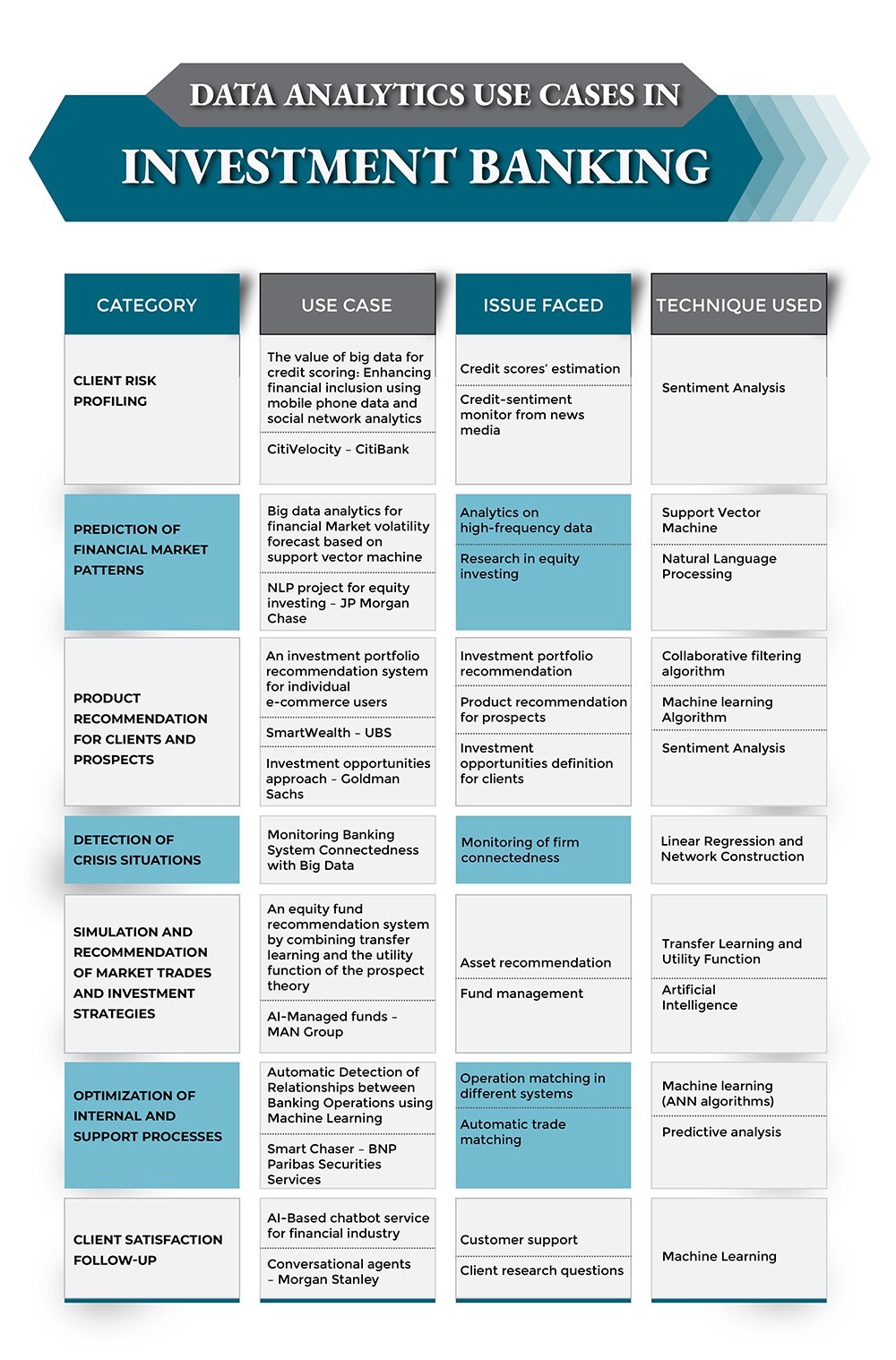
With the transformations in digitalization, investment opportunities have become accessible to all. The opportunities to invest one’s money are diverse, ranging from stocks and gold to investing in Information Technology (IT). As technology enhances, the traditional way of supporting and engaging in any financial transaction is quickly changing. Capital Markets are the key pillars of the global economy. They gather skilled finance, IT professionals, and economists to get the best investment decisions and choose the perfect funding solutions. The optimizations and innovations have a huge financial impact, to tackle this in a better way data analytics in investment banking plays an active role.
In this article, let’s discuss how data analysis in investment banking is transforming the way investment banks work, the challenges that they get when engaging in this transformation process, use cases, and more.
Analytics is a buzzword that is used everywhere and in various contexts. According to a recent survey from Atos, “66 percent of banking leaders consider transforming the digital client experience a top priority for the coming years.” Several research papers were published on several international platforms, which clearly state that investment banking can reap maximum benefits with analytics.
Data analytics in investment banking is a result of a rigid conjuncture that led to weak returns compared to older times. In the last few years, the financial sector and capital markets have witnessed a few years of stagnation of revenues provided to the fall of margins and the growing complexity of regulations. Also, the Fixed Income, Currencies, and Commodities business, which have historically filled the greater share of revenues, face an essential share declining for the same reasons.
Data analytics has therefore created its place at the center of the investment banks’ as it ensures better returns more deliberately.
Investment banking is the area where resources are heavily invested in risk because the consequences of a bad risk assessment could be devastating. The 2008 financial crisis and its impact on the global economy is the perfect example to describe the major role of this business line. To manage these risks, banks use data analysis tools to detect situations where there is a higher probability of defaulting on loans which gives them to take early action before things get uncontrollable. This applies to all kinds of risks. They are:
Fraud reduction is a common objective for investment banks. Data analytics can be leveraged to identify patterns of fraudulent transactions or atypical operations to manage risk, and also alert the appropriate personnel to investigate further instead of just detecting fraud.
Data analytics is helpful to identify and rate individual customers who are at risk of fraud and then apply various levels of monitoring and verification to those accounts. Analyzing the risk of the accounts gives investment banks to know what needs to be prioritized in their fraud detection efforts.
Liquidity risk is macro, such as interest rate fluctuations, changes in foreign exchange rates, and changes in the value of other financial instruments, such as bonds. It is the threat that a bank's assets will fall below the amount needed to get its liabilities.
Liquidity risk occurs when the availability of funds is inadequate. This can be caused due to bad loans (which may not ever be repaid) or lower-than-expected cash flows (which include lower-income/deposits). This is mainly risky for banks because their funding inputs are usually deposits, which are paid out as a net of interest.
Operational risk describes the potential for loss due to actions taken by the business. They are possible losses that result directly from risks associated with day-to-day operations, i.e., fraud, theft, computer security breaches, or error in judgment or incompetence at an executive level.
Data analytics is used to keep track of the short and long-term liquidity every time, they also assess the impact of transactions on liquidity in real-time and run simulations and stress tests regularly to make sure that the required funds for investment banks to function accurately.
Investment banks take help from analytics to manage the risk associated with the loans they make. This is done by monitoring data they collect on individual customers. This data can have the following, but it is not limited to:
Customer credit score
Credit card utilization (how much you owe)
Amounts owed on various credit cards (total debt)
Amounts owed on various kinds of credit (total debt/total credit)
Credit risk analysis is the analysis of earlier data to gather the borrower's creditworthiness or to assess the risk involved in providing the loan. Where internal data about clients and counterparties is gathered with external data from the web, social media, and the news to get an exhaustive feel of their financial situation and ensure that the hazards are well managed. The results of this analysis will help investment banks to analyze their risks and those of their customers.
Risk modeling is the process of simulating the portfolio of assets (stocks, bonds, futures, options, etc.) or a single asset (interest rate) moves in response to various scenarios. When risk modeling is done accurately and consistently across all assets, one can reduce the portfolio's overall risk and enhance its performance. Risk models are used in several areas with financial institutions to get the risky aspects
Sentiment analysis plays a role here to better understand the demands of the customers and address them accurately. The data available on the web, including the news, social media, research reports, and corporate websites, gives better ways to know the customer. The anticipation with which the client might or might not appreciate, and direct them to the most suitable products (cross and up-selling) at the right time. This also ensures enhanced customer loyalty, pleasing them and also makes attracting prospects a more successful process.
Data analytics in investment banking offers massive and thorough monitoring where patterns of incidents and issues get identified by using Machine Learning (ML) algorithms. This makes the handling and resolution a much easy process.

Investment bankers tackle a myriad of challenges related to data and productivity, particularly dealing with managing the demand side of the equation, which is an all-time high activity.
One of the main challenges people who want to excel in investment banking career must know about this – the investment banks face when beginning analytics use cases is to prioritize them. In the use cases listed in the above section, there are so many inter-dependencies between the use cases because they mostly rely on the same data: a mix of internal deals and operations with the market and economic data. Thus, knowing as well as deciding on what use cases one need to opt for first are a matter of business priorities and also a matter of technical constraints, related to data availability.
The initial point leads to the second concern of data analytics projects in the area that is good that the whole data is accessible. The analytics in capital markets lies in the accurate combination of internal and external data that is not always available in internal databases and is rather present in data providers’ platforms, social networks, and websites of regulatory entities, ministries, national agencies, and clients.
The massive amounts of data investment banking may end up processing due to the vast scope of external data required for analytics, the nature of the data repository/ data used can also be a tough decision to make, and one that significantly impacts the long run and price of the analytics initiatives. There is an essential trade-off to make between the strict regulations on investment banks and the data confidentiality they need and the big data in investment banking volumes to process, in which a big chunk is mainly public and already present to each one on the net.
The technical and technological architecture of the environment hosting data analytics use cases is one of the challenging situations. The peculiarity of the external data required for investment banks is that it is highly presented in several files (pdf, word, or excel) of small or medium sizes since every publication is available in a separate document. Block storage, which is highly used in data analytics in all the other domains is not the preferred option as it is not initially designed for the storage of small files.
An investment banking career is a global, high-value, and highly competitive area of banking. Like all other sectors, it is based heavily on data analytics, not merely for the competitive edge but also routine functions. With the use of data analytics for solutions, investment bankers can cut down on repetitive and manual work and use their time and energy in high-value endeavors.